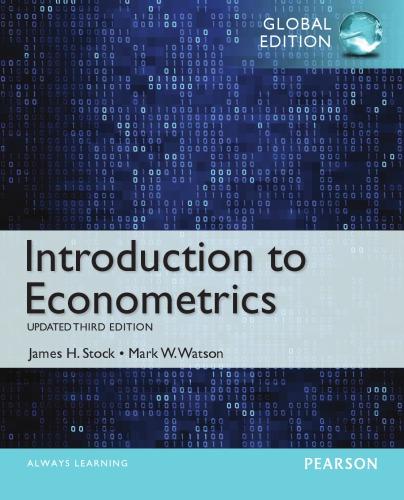E12.2 Does viewing a violent movie lead to violent behavior? If so, the incidence of violent crimes,
Question:
E12.2 Does viewing a violent movie lead to violent behavior? If so, the incidence of violent crimes, such as assaults, should rise following the release of a violent movie that attracts many viewers. Alternatively, movie viewing may substitute for other activities (such as alcohol consumption)
that lead to violent behavior, so that assaults should fall when more viewers are attracted to the cinema. On the textbook website, www
.pearsonglobaleditions.com/Stock_Watson, you will find the data file Movies, which contains data on the number of assaults and movie attendance for 516 weekends from 1995 through 2004.5 A detailed description is given in Movies_Description, available on the website. The dataset includes weekend U.S. attendance for strongly violent movies (such as Hannibal), mildly violent movies (such as Spider-Man), and nonviolent movies (such as Finding Nemo). The dataset also includes a count of the number of assaults for the same weekend in a subset of counties in the United States. Finally, the dataset includes indicators for year, month, whether the weekend is a holiday, and various measures of the weather.
a. i. Regress the logarithm of the number of assaults [ln_assaults =
ln(assaults)] on the year and month indicators. Is there evidence of seasonality in assaults? That is, do there tend to be more assaults in some months than others? Explain.
ii. Regress total movie attendance (attend = attend_v + attend_m +
attend_n) on the year and month indicators. Is there evidence of seasonality in movie attendance? Explain.
b. Regress ln_assaults on attend_v, attend_m, attend_n, the year and month indicators, and the weather and holiday control variables available in the data set.
i. Based on the regression, does viewing a strongly violent movie increase or decrease assaults? By how much? Is the estimated effect statistically significant?
ii. Does attendance at strongly violent movies affect assaults differently than attendance at moderately violent movies? Differently than attendance at nonviolent movies?
iii. A strongly violent blockbuster movie is released, and the weekend’s attendance at strongly violent movies increases by 6 million;
meanwhile, attendance falls by 2 million for moderately violent movies and by 1 million for nonviolent movies. What is the predicted effect on assaults? Construct a 95% confidence interval for the change in assaults. [Hint: Review Section 7.3 and material surrounding Equations (8.7) and (8.8).)]
c. It is difficult to control for all the variables that affect assaults and that might be correlated with movie attendance. For example, the effect of the weather on assaults and movie attendance is only crudely approximated by the weather variables in the data set. However, the data set does include a set of instruments, pr_attend_v, pr_attend_m, and pr_attend_n, that are correlated with attendance but are (arguably) uncorrelated with weekend-specific factors (such as the weather) that affect both assaults and movie attendance. These instruments use historical attendance patterns, not information on a particular weekend, to predict a film’s attendance in a given weekend.
For example, if a film’s attendance is high in the second week of its release, then this can be used to predict that its attendance was also high in the first week of its release. (The details of the construction of these instruments are available in the Dahl and DellaVigna paper referenced in footnote 5.) Run the regression from part
(b) (including year, month, holiday, and weather controls) but now using pr_ attend_v, pr_attend_m, and pr_attend_n as instruments for attend_v, attend_m, and attend_n. Use this regression to answer (b)(i)–(b)(iii).
d. The intuition underlying the instruments in
(c) is that attendance in a given week is correlated with attendance in surrounding weeks. For each move category, the data set includes attendance in surrounding weeks. Run the regression using the instruments attend_v_f, attend_m_f, attend_n_f, attend_v_b, attend_m_b, and attend_n_b instead of the instruments used in part (c). Use this regression to answer (b)(i)–(b)(iii).
e. There are nine instruments listed in
(c) and (d), but only three are needed for identification. Carry out the test for overidentification summarized in Key Concept 12.6. What do you conclude about the validity of the instruments?
f. Based on your analysis, what do you conclude about the effect of violent movies on (short-run) violent behavior?
Step by Step Answer:

Introduction To Econometrics
ISBN: 9781292071367
3rd Global Edition
Authors: James Stock, Mark Watson






